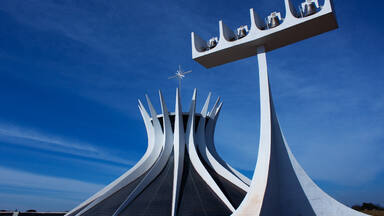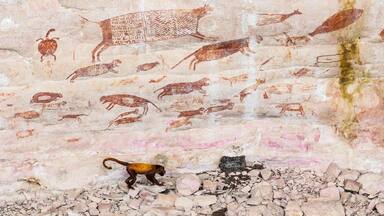Göbekli Tepe
Göbekli Tepe
Located in the Germuş mountains of south-eastern Anatolia, this property presents monumental round-oval and rectangular megalithic structures erected by hunter-gatherers in the Pre-Pottery Neolithic age between 9,600 and 8,200 BCE. These monuments were probably used in connection with rituals, most likely of a funerary nature. Distinctive T-shaped pillars are carved with images of wild animals, providing insight into the way of life and beliefs of people living in Upper Mesopotamia about 11,500 years ago.
Description is available under license CC-BY-SA IGO 3.0
Göbekli Tepe
Situé dans la chaîne montagneuse du Germuş, en Anatolie du sud-est, ce bien présente des structures mégalithiques monumentales de forme ronde-ovale et rectangulaire érigées par des groupes de chasseurs-cueilleurs du néolithique précéramique, entre 9600 et 8200 avant notre ère. Ces monuments auraient vraisemblablement été utilisés dans le cadre de rituels, probablement funéraires. Des piliers caractéristiques en forme de T sont sculptés d’animaux sauvages qui donnent un aperçu de la vision du monde et des croyances des populations vivant en Haute Mésopotamie il y a environ 11 500 ans.
Description is available under license CC-BY-SA IGO 3.0
غوبيكلي تيبي
يمثل هذا الموقع، الموجود في سلسلة جبال غيرموس جنوب شرق الأناضول، إنشاءات معمارية مغليثية ضخمة دائرية ومستطيلة الشكل. وتفسر هذه الإنشاءات على أنها منشآت صخرية محصنة شيدها مجموعات من الصيادين والمزارعين في العصر الحجري الحديث بين عامي 9600 و 8200 قبل الميلاد. ولا شك أنّ هذه الآثار استخدمت لأغراض الطقوس الدينية، وربما في إحياء مراسم الدفن تحديداً. وقد نُقش على الأعمدة النمطية، المشيدة على شكل حرف T باللغة الإنجليزية رسومات لحيوانات برية، الأمر الذي يقدّم لمحة عن نظرة السكان حينها للعالم، وكذلك عن المعتقدات التي كانت لديهم في شمال بلاد الرافدين منذ قرابة 11500 عام.
source: UNESCO/CPE
Description is available under license CC-BY-SA IGO 3.0
哥贝克力石阵
该遗产地位于安纳托利亚东南部的Germuş山脉,特征为巨大的圆形和矩形巨石结构,据信为狩猎采集者在公元前9600-8200年之前的陶器新石器时代竖立,被称为城邑。这些古迹很可能与丧葬仪式有关,独特的T形柱子上刻有野生动物的图像,从中可以窥见约1.15万年前生活在上美索不达米亚的人类的生活方式和信仰。
source: UNESCO/CPE
Description is available under license CC-BY-SA IGO 3.0
Гёбекли-Тепе
Расположенный в горной цепи Гермуш в юго-восточной Анатолии, этот объект представляет монументальные круглые и прямоугольные мегалитические сооружения, которые интерпретируются как укрепления, возведенные группами охотников-собирателей эпохи Докерамического неолита между 9600 и 8200 гг. до н.э. Без сомнения, эти сооружения использовались при совершении ритуалов, вероятно, погребальных. На характерных Т-образных столбах высечены контуры диких животных, дающие общее представление об искусстве и верованиях народов, проживавших на территории Верхней Месопотамии около 11 500 лет назад.
source: UNESCO/CPE
Description is available under license CC-BY-SA IGO 3.0
Göbekli Tepe
Situado al sudeste de Anatolia, en lo alto del Monte Germus, este sitio posee toda una serie de monumentos megalíticos circulares y rectangulares dispuestos en forma de recintos, que fueron erigidos por poblaciones de cazadores-recolectores en la etapa del Periodo Neolítico anterior a la alfarería (9600-8200 a.C.). Utilizados para la ejecución de rituales, probablemente funerarios, estos recintos poseen altos pilares en forma de T con animales salvajes esculpidos que nos dan una idea de la cosmovisión y las creencias de los pobladores de la Alta Mesopotamia hace unos 11.500 años.
source: UNESCO/CPE
Description is available under license CC-BY-SA IGO 3.0
Outstanding Universal Value
Brief synthesis
Göbekli Tepe is located in Upper Mesopotamia, a region which saw the emergence of the most ancient farming communities in the world. Monumental structures, interpreted as monumental communal buildings (enclosures), were erected by groups of hunter-gatherers in the Pre-Pottery Neolithic period (10th-9th millennia BC). The monuments were probably used in connection with social events and rituals and feature distinctive limestone T-shaped pillars, some of which are up to 5.50 meters tall. Some of the pillars, which are abstract depictions of the human form, also feature low reliefs of items of clothing, e.g. belts and loincloths, as well as high and low reliefs of wild animals. Recent excavation works have also identified the remains of non-monumental structures which appear to stem from domestic buildings.
Criterion (i): The communities that built the monumental megalithic structures of Göbekli Tepe lived during one of the most momentous transitions in human history, one which took us from hunter-gatherer lifeways to the first farming communities. The monumental buildings at Göbekli Tepe demonstrate the creative human genius of these early (Pre-Pottery Neolithic) societies.
Criterion (ii): Göbekli Tepe is one of the first manifestations of human-made monumental architecture. The site testifies to innovative building techniques, including the integration of frequently decorated T-shaped limestone pillars, which also fulfilled architectural functions. The imagery found at Göbekli Tepe, adorning T-pillars and some small finds (stone vessels, shaft-straighteners, etc.), is also found at contemporaneous sites in the Upper Mesopotamian region, thus testifying to a close social network in this core region of Neolithisation.
Criterion (iv): Göbekli Tepe is an outstanding example of a monumental ensemble of monumental megalithic structures illustrating a significant period of human history. The monolithic T-shaped pillars were carved from the adjacent limestone plateau and attest to new levels of architectural and engineering technology. They are believed to bear witness to the presence of specialized craftsmen, and possibly the emergence of more hierarchical forms of human society.
Integrity
Göbekli Tepe contains all the elements necessary for the expression of its Outstanding Universal Value and is of adequate size to ensure the complete presentation of the features and processes which convey its significance.
The physical fabric of the property is in good condition and the processes of deterioration are monitored and carefully controlled.
The conditions of integrity are potentially vulnerable in the buffer zone and wider setting of the property due to the future infrastructure projects (railway line) and the increase in visitor numbers likely to be generated.
Authenticity
The megalithic structures have largely retained the original form and design of their architectural elements, together with numerous decorative elements and craft works that provide an insight into the way of life of the societies that occupied the site. The results of more than twenty years of research and archaeological excavations on the site testify to its authenticity. Excavations and research under way since the mid-1990s also provide a more balanced and detailed view of the relationship between the various aspects of usage and the prehistoric importance of the property.
Protection and management requirements
Göbekli Tepe is legally protected by Law 2863/1983 on the Protection of the Cultural and Natural Properties, amended in 1987 and 2004. In 2005, the tell and the limestone plateau were inscribed as a 1st Degree Archaeological Conservation Site by the decision of the Diyarbakır Council for Conservation of Cultural and Natural Properties. In 2016, the buffer zone was registered as a 3rd Degree Archaeological Conservation Site, by the decision of the Şanlıurfa Council for Conservation of Cultural Properties.
The institutional framework for the implementation of the protection measures consists at national level of the Ministry of Culture and Tourism, at regional level of the Şanlıurfa Council for Conservation of Cultural Properties, and at local level of Şanlıurfa Museum. Since 2014 the Ministry of Culture and Tourism has granted an excavation permit to Şanlıurfa Museum in collaboration with the German Archaeological Institute .
The property, its buffer zone and its wider setting are protected by a strict regime of maintenance and control, derived from extensive statutory protection and state ownership. The Ministry of Culture and Tourism, through the Şanlıurfa Museum and the German Archaeological Institute, has in place an effective system of monitoring of all the assets and their condition, which includes an ongoing maintenance programme.
The management plan was drawn up in 2013, revised in 2016 and finalised in 2017. Within the framework of the revised conservation legislation (Protection of Cultural and Natural Properties Law No.2863, 23/07/1983 as amended by the Law No.5226, 14/07/2004) and its supplementary Regulation on the Substance and Procedures of the Establishment and Duties of the Site Management and the Management Council and Identification of Management Sites No.26006, 27/11/2005, a site manager was appointed in 2014. An Advisory Board, set up in 2016, examines the management plan and submits proposals for decision-making and the implementation of the plan. A Coordination and Audit Board, also set up in 2016, examines and approves the draft master plan.



